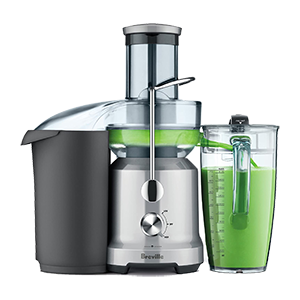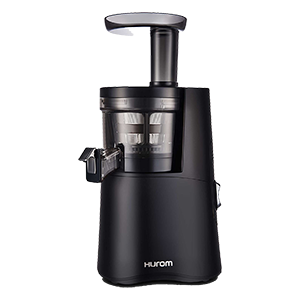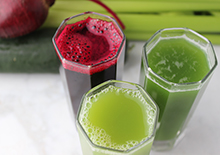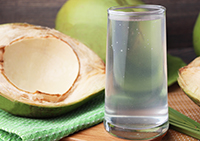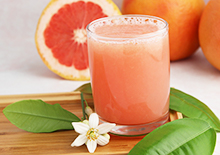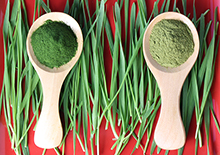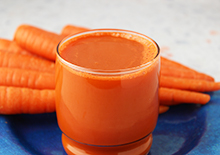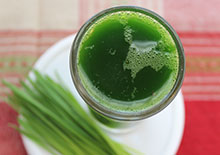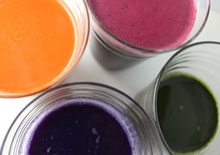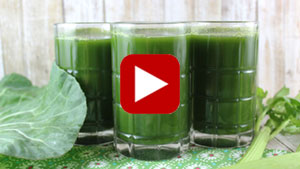- Home
- Super Juicing
- Benefits of Drinking Green Juice
Benefits of Drinking Green Juice, Reset, Restore and Revitalize
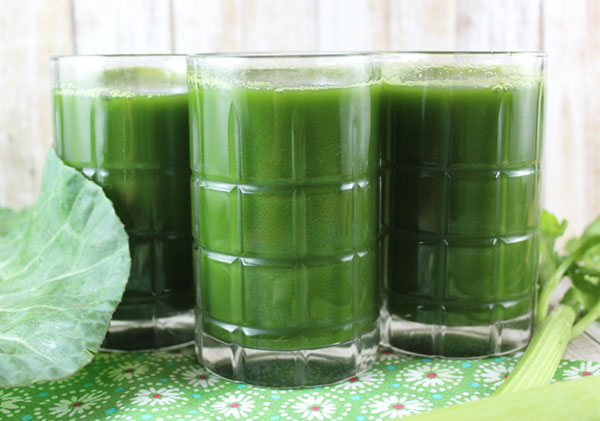
Green juice is the concentrated liquid created from cold-pressing raw low-sugar vegetables and leafy greens through a juicer.
While the initial concept of consuming green juice started way back in the 1930's as a therapeutic treatment for many chronic illnesses, in the past several decades "green juicing" has become an increasingly popular trend amid health-conscious communities worldwide.
Table of Contents
Intro | Top 4 Benefits | How to Make Green Juice | Precautions | Shop
The specific types we are referring to are raw and unpasteurized, preferably homemade or freshly pressed using organic high-quality produce. Consumed first thing in the morning for highest nutrient uptake, drinking green juice is considered a health-enhancing liquid for several reasons.
Top 4 Benefits of Drinking Green Juice
1) Immediate Nutritional Fortification
2) Cleansing to the Blood, Promotes Detoxification
3) Good for Weight Loss and Healthy Gut Bacteria
4) Can Help to Reduce Inflammation
1) Immediate Nutritional Fortification That Boosts Natural Energy
Green juice is a super concentrated plant-based liquid that is filled with nutrients, enzymes and antioxidants like chlorophyll and carotenoids. Because the fiber is removed, the extracted juice is easily absorbed, providing an immediate influx of potent nutritional nourishment.
Green leafy vegetable juices are particularly high in bioavailable minerals and certain vitamins. While ratios are unique to each type of leafy green, most are good sources of calcium, vitamin K, folate, vitamin C, potassium, beta-carotene, calcium and iron.
The Benefits of Drinking Green Juice Can Be Helpful for Those Who Have:
- Impaired digestive functions who are unable to properly metabolize solid foods.
- Challenges with consuming adequate amounts of vegetables on a daily basis.
- Undernourishment and mineral deficiencies from poor long-term dietary food choices.
Drinking a green juice first thing in the morning can be a great way to stimulate natural energy without the use of caffeinated stimulants.
Added spices like ginger root or hot peppers can also help to increase
nutrient delivery and activate cleansing effects. This can have a
positive influence on overall mood, providing greater feelings of
well-being, clarity as well as renewed physical energy.
Cold-pressed juice from organic raw vegetables, low-sugar fruits and chlorophyll-infused leafy greens are also full of energizing amino acids and can be a great pick me up when you feel fatigued or sluggish between meals.
One cup of raw kale, according to nutrition data, contains 2.2g of protein or 4% of the Daily Value (based on a 2,000 calorie diet). When juicing, one typically uses more leafy greens, so this amount could easily double. (*)
2) Cleansing to the Blood and Promotes Detoxification
The process of detoxification is fundamentally an "ongoing biological process." As long as we are living with a functioning liver, colon and kidneys, the body is always in some state of detox, filtering out wastes and toxins. This is what these organs are designed to do.
However, an accumulation of toxic substances can occur over time from unhealthy lifestyle habits, dietary excess and/or environmental pollutants we are all invariably exposed to on a daily basis. This is commonly believed to place undue stress on these mentioned organ systems and further impede optimal detoxification processes.
Chlorophyll-concentrated green juices and their easily digested nature can be extremely cleansing to the bloodstream, purifying to the lymph and liver, and can encourage the removal of toxic substances from the body.
Keep in mind, that it is important to select organic produce when making homemade green juice, as conventionally-grown vegetables when juiced will concentrate pesticide residues.
Dietary chlorophyll is also a commonly prescribed nutrient for clearing skin issues as well as reducing bad breath and body odor.
Many health experts agree that short periodic fasting on green juice is one of the most basic and effective dietary regime's you can adhere to when feeling off-balance, sick, constipated, fatigued or stressed.
For long-term health maintenance, intermittent cleansing practices using green juice blends help to keep the body's detoxification pathways open and unhindered.
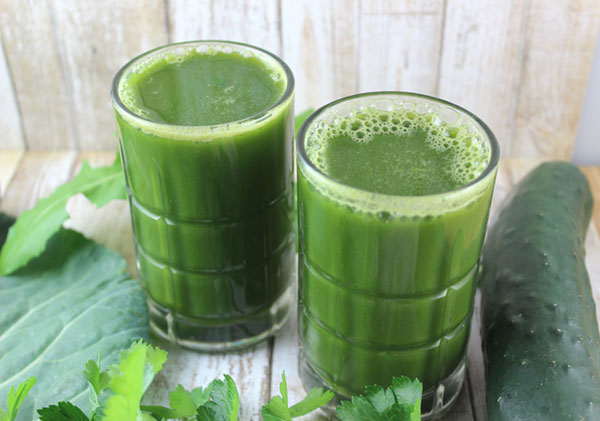
3) Good for Weight Loss and Healthy Gut Bacteria
The benefits of drinking green juice can also be applied to those seeking to lose unwanted body weight. A quart of fresh homemade low-sugar green juice makes an appetizing satisfying meal replacement that is full of phytonutrients yet low in calories. Likewise, these green drinks help to reset digestive functions, normalize bowel movements and prevent constipation.
Drinking fresh raw juice from greens and low-sugar fruits and vegetables, high in alkalizing mineral content, likewise feeds healthy gut bacteria, wards off parasites and keeps fungal yeast strains, like candida, in check.
4) Can Help to Reduce Inflammation
Systemic inflammation seems to be at the root of almost every known chronic health disorder. Along with adhering to healthy lifestyle activities, dietary food choices can often play a large part in neutralizing inflamed conditions.
Note: For those with hypothyroid issues, cruciferous leafy greens and vegetables should be avoided because of their potentially high goitrogen content. In such cases, cucumber and celery can be juiced with other non-cruciferous selections like dandelion greens, spinach, cilantro, parsley and lettuce.
Most of the dark leafy green vegetables are good sources of omega-3 ALA fatty acids, one of the anti-inflammatory nutrients nutritionally valued as essential fats for the brain and cardiovascular system. A health promoting diet should include adequate amounts of them on a regular basis and drinking green juices is one great way to achieve this objective.
Cruciferous vegetables, like kale, collard and arugula, are also known anti-inflammatory agents. These greens contain the antioxidant chlorophyll in addition to sulfur-bearing compounds, two components of which become especially concentrated when green juicing. Chlorophyll A has been identified in research to have promising effects for the treatment of inflammation and related diseases. (*) Dietary sulfur is believed to be beneficial to the joints by helping to reduce inflammation and alleviate pain. (Source)
It is also possible to add other ingredients such as turmeric and ginger to your green juice recipes to further promote anti-inflammatory effects.
One of the benefits of drinking green juice is that it can subsequently help to alleviate inflammatory disorders like ulcerative colitis and inflammatory bowel disease. It is, however, always best to seek medical advice in such situations.
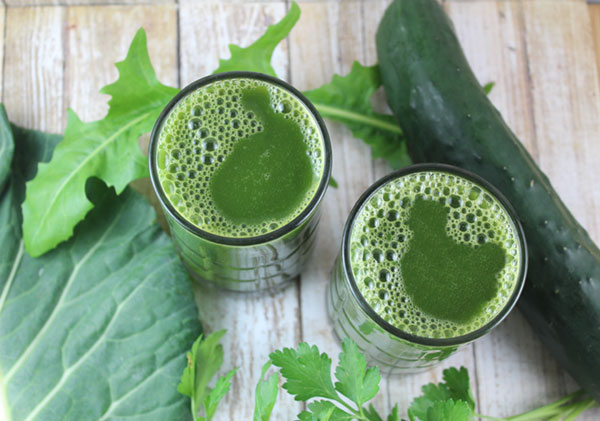
How to Make Green Juice
If you are new to their flavor, green juices can take a little
getting used to as the first sip is not necessarily appealing to the
taste buds. This is because, when properly made, they are low in sugar
content.
Don't have a juicer? Learn about how to juice with a blender!
Green juice recipes are typically prepared with base vegetables like celery and cucumber,
their main components of course include different combinations of greens
like kale, collard, parsley, lettuce, spinach, cabbage, cilantro and sprouts as well as wild edibles like dandelion and chickweed. They can therefore have a very "green" sometimes bitter taste.
Often flavor can be improved by adding tastier selections such as mint and fennel in addition to ginger, lemon or lime as well as small amounts of green apples if needed. To make green juices sweeter without increasing the sugar quantity significantly, you can also add in stevia or coconut water.
Most people frequently find they adjust to the taste over time and actually look forward to the benefits of drinking green juice and its health-enhancing side-effects.
Precautions:
For people with an under-active thyroid or hypothyroidism, some health authorities believe it is best to avoid concentrated amounts of cruciferous leafy green vegetables. Juiced vegetables high oxalate content should be avoided by those with kidney disease or prone to kidney stones. Seek the advice of your physician if you are pregnant, nursing, taking prescription medications or have a serious medical condition.

